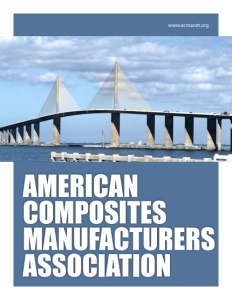American Composites Manufacturers Association
A voice for the industry
Business View Magazine interviews Tom Dobbins, ACMA’s President, as part of our series on the composites industry.
The American Composites Manufacturers Association (ACMA) is the world’s largest trade association serving the composites industry. Its mission is to provide education and information to the industry, lobby for its members and affiliates, and develop and expand markets for the manufacturers and distributors of composite products.
 A composite material is any material made from two or more constituent materials with significantly different physical or chemical properties that, when combined, produce a material with characteristics different from the individual components. The new material may be preferred for many reasons: common examples include materials which are stronger, lighter, or less expensive when compared to traditional materials.
A composite material is any material made from two or more constituent materials with significantly different physical or chemical properties that, when combined, produce a material with characteristics different from the individual components. The new material may be preferred for many reasons: common examples include materials which are stronger, lighter, or less expensive when compared to traditional materials.
The earliest man-made composite materials were straw and mud, which were combined to form bricks for building construction in the ancient world. Concrete is also a composite material, made of aggregate bonded together with a fluid cement that hardens over time, and is used more than any other man-made material on the planet. One of the most common and familiar composites is fiberglass, in which small glass fibers are embedded within a polymeric material, normally an epoxy or polyester. The glass fiber is relatively strong and stiff, but also brittle, whereas the polymer is ductile, but also weak and flexible. Thus, the resulting fiberglass is relatively stiff, strong, flexible, and ductile.
According to Tom Dobbins, ACMA’s President, the Association has its roots in two earlier organizations. “One root of the tree is the Fiberglass Fabricators Association, which was made up of small fiberglass fabricators and was originally formed in 1979 to network and share ideas and overcome problems. Like all associations, they wanted to come together to do what they couldn’t do on their own. The other root of the organization goes back to the old Society of the Plastics Industry (founded in 1937). There was a composites division within that organization. Around the late ‘90s or early 2000s, the two groups merged and became the American Composites Manufacturers Association.”
“Again,” he continues, “the idea was that the industry should be unified to be able to speak with one voice and to work together to forward our major goals, which are: to provide education to the industry at all levels – from the worker on the plant floor to the executive in the C-suite; to provide information and market intelligence throughout the companies; and to provide legislative and regulatory advocacy to make sure that we have commonsense regulations and legislation. The final, and, arguably, the premier mission of the organization, is market growth and development – to help grow the composites market.”
Today, the ACMA has about 500 members out of approximately 3,000 composite manufacturers in the U.S. and Canada. But Dobbins says that, whether or not a company is member, the Association represents all of them in the work that it does: “So, when we open markets, we open them for all of them. When we fix a regulation, we do it for all of them. We represent companies that are doing high performance work in aerospace and defense, and companies that are making boats and bathtubs. We’re the voce for the entire industry.”
The ACMA has a staff of 24 who are responsible for executing all the programs in the Association’s four areas of focus: education and communication, market intelligence, advocacy, and market penetration. Dobbins explains: “We have people who are out developing and helping to promote our Certified Composite Technician program; we have people who are putting together the programming for our trade show that we do jointly with the Society for the Advancement of Material and Process Engineering, and for our conferences; they’re producing our magazine and newsletters and websites; we have staff who are experts in working on Capitol Hill; we have people who are experts in working with federal agencies on complex regulatory issues and science around some of the chemicals that we’re using; and then, we have experts in market growth and development. They do OEM visits and workshops; they organize trade shows for architects and corrosion engineers and bridge engineers. They’re doing marketing outreach to publications and social media to reach design professionals and help them understand the advantages of composites.”
Regarding the penetration into new markets, Dobbins believes that there are two areas that “are about to explode. The first is automotive,” he reports. “We have tremendous interest from the OEMs in terms of using composites to make vehicles lighter, safer, and more resilient. We talk to OEMs that really want to accelerate their move to composites and do it even faster than Ford did in moving to aluminum.” In fact, this past April, the ACMA sponsored a technology day at the Ford Automobile Company – some 40 composites companies exhibited their products and gave presentations for several hundred Ford engineers and its senior leadership team.
 Dobbins believes that, eventually, instead of composites being an add-on to automobiles, which are made mostly of steel, new cars will be made mostly of composites, with steel components used only where they are absolutely needed. “And that will change the whole design parameters for the car,” he declares. “You can make very complex shapes with composites that you can’t make with steel. So, you can do a lot of part production for automotive that will eliminate steel parts and manufacturing. And, once that happens, it’s a lot easier to attach composites to composites than it is to try to work them in and replace a steel part with a composite part.”
Dobbins believes that, eventually, instead of composites being an add-on to automobiles, which are made mostly of steel, new cars will be made mostly of composites, with steel components used only where they are absolutely needed. “And that will change the whole design parameters for the car,” he declares. “You can make very complex shapes with composites that you can’t make with steel. So, you can do a lot of part production for automotive that will eliminate steel parts and manufacturing. And, once that happens, it’s a lot easier to attach composites to composites than it is to try to work them in and replace a steel part with a composite part.”
“The second market that I think is going to show tremendous growth, and Canada has been a leader in this market, is composites in infrastructure,” Dobbins adds. “The composites industry makes rebar that’s lighter and stronger than steel and is completely corrosion-proof, so it makes sense to use that over traditional materials. We see that market with the potential to really take off, quickly. In fact, one of our leading suppliers, Owens-Corning, recently purchased a company that makes rebar, so they expect this market to take off, too.”
Another market that is continuing to expand is aerospace. Indeed, Boeing’s latest aircraft, the 787 Dreamliner, is made primarily out of composites. “And they’re actually going back and retrofitting the 777s,” says Dobbins. “They’re making tail assemblies out of composites; the wings are being made out of composites. So, Boeing sees the future; Ford sees the future. And although we’ve taken over boats and windmill blades and other markets, when you’re moving from a niche technology, and you see major OEMs starting to look at composites, that’s a huge change.”
In terms of future areas, Dobbins also sees a major push to market composites to design professionals such as architects and engineers. “That’s a whole new area,” he notes. “I think that, in addition to thermosets, which is a resin system that we use, you will see thermoplastics start emerging in composites with very quick adoption for certain applications.” (Whereas thermoset plastics always remain in a permanent solid state, thermoplastics can be re-melted and cooled multiple times to form various shapes.) “So, I think you will start seeing more of a convergence and maturing of 3-D printing being done with composites for specialty applications and parts replacement.”
Moreover, Dobbins says that the technology to make composites recyclable is close to becoming a reality. “Metals can be recycled, but it takes huge amounts of energy,” he explains. “We will actually be recovering energy as we recycle composite materials and so, that’s a huge game changer in terms of our ability to compete against steel, aluminum, and other metals.”
Going forward, Dobbins says that the ACMA will continue to advocate for commonsense regulations on Capitol Hill and in state legislatures, just as it has done in the past. “We’ve tackled everything from federal issues with styrene exposure, dust, and fire safety regulations, to Proposition 65 in California, which requires labeling for chemicals. We covered odor issues in Texas, and operating permits in Ohio and Indiana. The U.S. is working on a major infrastructure bill as we speak and I anticipate, like the last three infrastructure bills that have been passed, there will be provisions in that bill that will promote the use of composites in U.S. infrastructure.”
“The organization is dynamic and growing,” Dobbins says in summation.”It’s very proactive in terms of working to open markets and it’s creating opportunities for its members to meet with current and new customers. We provide tangible work for our companies, and being a part of the Association is a tremendous return on investment in terms of opportunities for what they’re paying in dues. And there are some big things coming down the pike.”
Check out this handpicked feature on SGL Carbon LLC – The value chain advantage.
AT A GLANCE
WHO: American Composites Manufacturers Association
WHAT: The world’s largest trade association serving the composites industry
WHERE: Arlington, Virginia
WEBSITE: www.acmanet.org


